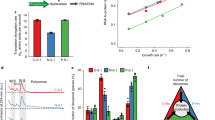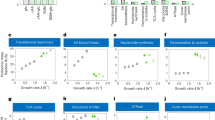Abstract
RecombinantEscherichia coli, which overproduce heterologous protein, redirect endogenous metabolic activity to that mediated by the recombinant expression vector. Consequently, cells may experience perturbations in the biosynthetic reaction network, including the amino acid biosynthesis pathways. These cells are characterized by decreased growth rate, decreased cell mass yield, and increased heterologous protein degradation. This study investigates the dynamics of chloramphenicol-acetyl-transferase (CAT) synthesis and degradation inE. coli JM105 grown on minimal media, and correlates the observed phenomena with induction strength. Coordinated amino acid feeding was shown to increase the heterologous protein yield. Rational design of nutrient feeding possibilities is explored.
Similar content being viewed by others
References
Bentley, W. E. and Kompala, D.S. (1990),Annals of the New York Academy of Sciences 389, 121–138.
Neidhardt, F. C., Ingraham, J. L., and Schaechter, M. (1990),Physiology of the Bacterial Cell: A Molecular Approach Sinauer Associates, Sunderland, MA.
Bentley, W. E. and Kompala, D.S. (1990),Biotechnology Letters 12, 329–334.
Goff, S. A. and Goldberg, A. L. (1985),Cell 41, 587–595.
Neidhardt, F. C., VanBogelen, R. A., and Vaughn, V. (1984),Annual Review of Genetics 18, 295–329.
Phillilps, T. A., VanBogelen, R. A., and Neidhardt, F. C. (1984),Journal of Bacteriology 159, 283–287.
Lindquist, S. and Craig, E. A. (1988),Annual Review of Genetics 22, 631–677.
Patrusky, B. (1990),Mosaic 21, 2–11.
Larimore, F. S., Waxman, L., and Goldberg, A. L. (1982),The Journal of Biological Chemistry 257, 4187–4195..
Grossman, A. D., Taylor, W. E., Burton, Z. F., Burgress, R. R., and Gross, C. A. (1985),Journal of Molecular Biology 186, 357–365.
Mizusawa, S. and Gottesman, S. (1983),Proc. Natl. Acad. Sci. USA 80, 358–362.
Chung, C. H. and Goldberg, A. L. (1981),Proc. Natl. Acad. Sci. USA 78, 4931–4935.
Rodriguez, R. L. and Tait, R. E. (1983),Recombinant DNA Techniques: An Introduction, Benjamin/Cummings, Menlo Park, CA.
Ramirez, D. M. (1991), Optimal Feeding Strategies for the Production of Foreign Proteins, MS Thesis, University of Maryland, College Park, MD.
Whitney, G. K., Glick, B. R., and Robinson, C. W. (1989),Biotechnology and Bioengineering 33, 991–998.
Bentley, W.E., Mirjalili, N., Anderson, D. C., Davis, R. H., and Kompala, D. S. (1990),Biotechnology and Bioengineering 35, 668–681.
Author information
Authors and Affiliations
Rights and permissions
About this article
Cite this article
Harcum, S.W., Ramirez, D.M. & Bentley, W.E. Optimal nutrient feed policies for heterologous protein production. Appl Biochem Biotechnol 34, 161–173 (1992). https://doi.org/10.1007/BF02920543
Issue Date:
DOI: https://doi.org/10.1007/BF02920543




